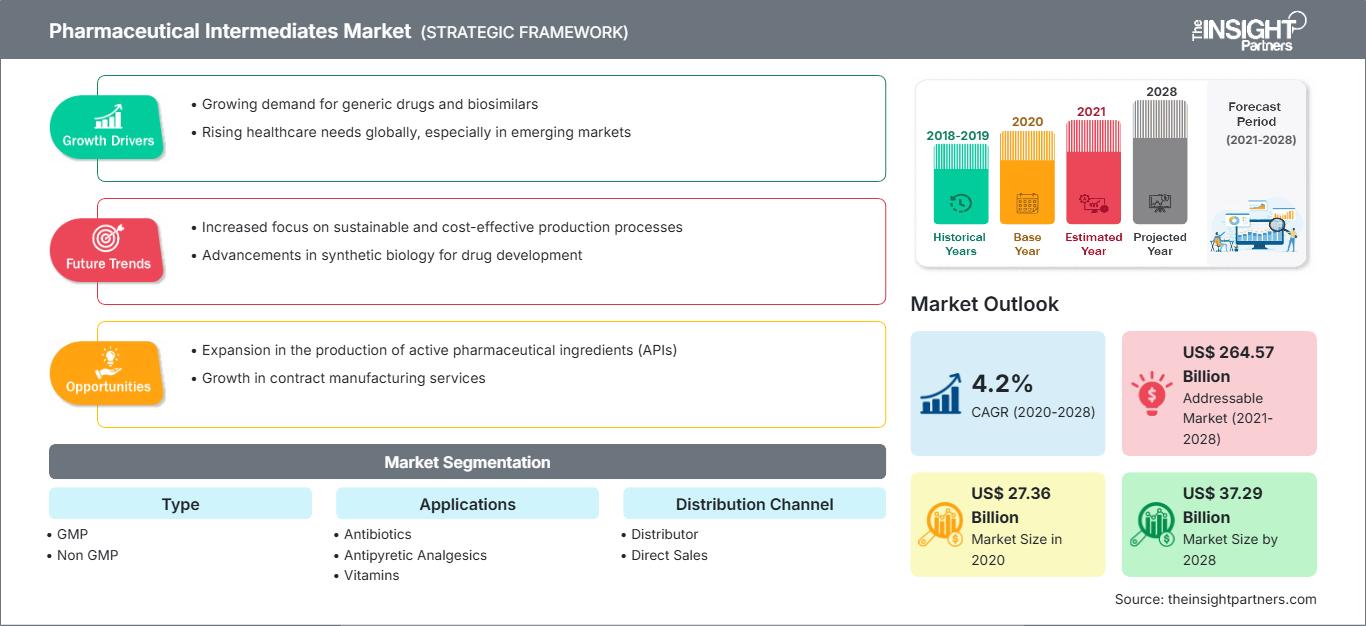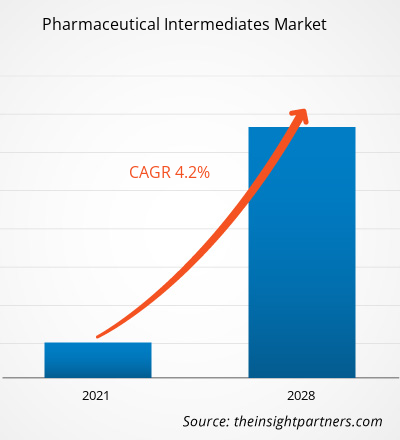The pharmaceutical intermediates market is expected to reach US$ 37,290.33 million in 2028 from US$ 27,356.70 million in 2020. The market is estimated to grow with a CAGR of 4.2% from 2021-2028.
The pharmaceutical intermediates market has been analyzed on the basis of type, application, distribution channel, and region. The market based on region is segmented into North America, Europe, Asia Pacific, the Middle East and Africa, and South and Central America. The report emphasizes on parameters such as market trends, technological advancements, market dynamics, and leading company’s competitive landscape analysis to offers insights and in-depth analysis of the pharmaceutical intermediates market. It also includes the analysis of COVID-19 pandemic across the market in all the key regions.
Customize This Report To Suit Your Requirement
You will get customization on any report - free of charge - including parts of this report, or country-level analysis, Excel Data pack, as well as avail great offers and discounts for start-ups & universities
Pharmaceutical Intermediates Market: Strategic Insights

-
Get Top Key Market Trends of this report.This FREE sample will include data analysis, ranging from market trends to estimates and forecasts.
Market Insights
Rising Prevalence of Chronic Diseases and Infectious Diseases
Pharmaceutical intermediates are the building blocks of active pharmaceutical ingredients (APIs). These are raw materials that undergo molecular change or processing during bulk drug production. Thus, the requirement of pharmaceutical intermediates increases with the rise in demand for drugs to treat chronic diseases. As per the Centers for Disease Control and Prevention (CDC), 6 in 10 adults in the US suffer from at least one chronic disease such as cancer, heart disease, lung disease, stroke, neurological disease, diabetes, and kidney diseases. Moreover, 4 in 10 adults in the country have two or more chronic diseases. Additionally, according to the press release by the European Chronic Disease Alliance (ECDA), in 2014, 9 out of 10 people in Europe die due to chronic diseases. Thus, 70–80% of the total healthcare costs are spent on the management of chronic diseases.
The surging prevalence of infectious diseases, especially in Southeast Asia, is also likely to propel the demand for APIs in the coming years, eventually driving the growth of the pharmaceutical intermediate market. For instance, as per the Revised National Tuberculosis Control Programme Report, around 4.4 lakh patients died due to tuberculosis in India in 2018, that is 29% of the total 1.5 million deaths caused by the disease across the world. Thus, such high prevalence of chronic diseases and infectious diseases is bolstering the demand for drugs, eventually highlighting the need of pharmaceutical intermediates.
Type-Based Insights
The pharmaceutical intermediates market, by type, is segmented into GMP, and non GMP. The GMP segment held the largest share of the market in 2020, whereas the same segment is anticipated to register the highest CAGR of 4.4% in the market during the forecast period.
Application-Based Insights
The pharmaceutical intermediates market, by application, is segmented antibiotics, antipyretic analgesics, vitamins, and others. The antibiotics segment held the largest share of the market in 2020, also, this segment is anticipated to register the highest CAGR of 4.9% in the market during the forecast period.
Distribution Channel-Based Insights
On the basis of distribution channel, the pharmaceutical intermediates market has been segmented into distributor, and direct sales. The direct sales segment held the largest share of the market in 2020, and distributor segment is estimated to register the highest CAGR of 4.2% in the market during the forecast period.
Companies operating in the pharmaceutical intermediates market are adopting organic strategies such as product launches and expansions to expand their footprint and product portfolio worldwide as well as to address the growing demands.
Pharmaceutical Intermediates Market Regional InsightsThe regional trends and factors influencing the Pharmaceutical Intermediates Market throughout the forecast period have been thoroughly explained by the analysts at The Insight Partners. This section also discusses Pharmaceutical Intermediates Market segments and geography across North America, Europe, Asia Pacific, Middle East and Africa, and South and Central America.
Pharmaceutical Intermediates Market Report Scope
| Report Attribute | Details |
|---|---|
| Market size in 2020 | US$ 27.36 Billion |
| Market Size by 2028 | US$ 37.29 Billion |
| Global CAGR (2020 - 2028) | 4.2% |
| Historical Data | 2018-2019 |
| Forecast period | 2021-2028 |
| Segments Covered |
By Type
|
| Regions and Countries Covered |
North America
|
| Market leaders and key company profiles |
|
Pharmaceutical Intermediates Market Players Density: Understanding Its Impact on Business Dynamics
The Pharmaceutical Intermediates Market is growing rapidly, driven by increasing end-user demand due to factors such as evolving consumer preferences, technological advancements, and greater awareness of the product's benefits. As demand rises, businesses are expanding their offerings, innovating to meet consumer needs, and capitalizing on emerging trends, which further fuels market growth.

- Get the Pharmaceutical Intermediates Market top key players overview
By Type
- GMP
- Non-GMP
By Application
- Antibiotics
- Antipyretic Analgesics
- Vitamins
- Others
By Distribution Channel
- Distributor
- Direct Sales
By Geography
-
North America
- US
- Canada
- Mexico
-
Europe
- Germany
- France
- Italy
- United Kingdom
- Spain
- Switzerland
- Belgium
- Greece
- Norway
- Portugal
- Sweden
- Czech Republic
- Croatia
- Ireland
- Denmark
- Netherland
- Russia
- Rest of Europe
-
Asia Pacific (APAC)
- China
- India
- South Korea
- Japan
- Australia
- Rest of APAC
-
Middle East and Africa (MEA)
- South Africa
- Saudi Arabia
- UAE
- Turkey
- Rest of MEA
-
South and Central America (SCAM)
- Brazil
- Argentina
- Rest of SCAM
Company Profiles
- Pfizer, Inc
- Dishman Group
- Dextra Laboratories Limited
- Sanofi Winthrop Industries S.A.
- Vertellus Holdings LLC
- BASF SE
- Lianhetech
- Codexis
- Midas Pharma GmbH
- Chiracon GmbH
Frequently Asked Questions
What is the cost of Pharmaceutical Intermediates?
What are Pharmaceutical Intermediates?
What are the driving factors for the Pharmaceutical Intermediates market across the globe?
- Historical Analysis (2 Years), Base Year, Forecast (7 Years) with CAGR
- PEST and SWOT Analysis
- Market Size Value / Volume - Global, Regional, Country
- Industry and Competitive Landscape
- Excel Dataset
Recent Reports
Related Reports
Testimonials
Reason to Buy
- Informed Decision-Making
- Understanding Market Dynamics
- Competitive Analysis
- Identifying Emerging Markets
- Customer Insights
- Market Forecasts
- Risk Mitigation
- Boosting Operational Efficiency
- Strategic Planning
- Investment Justification
- Tracking Industry Innovations
- Aligning with Regulatory Trends





















 Get Free Sample For
Get Free Sample For